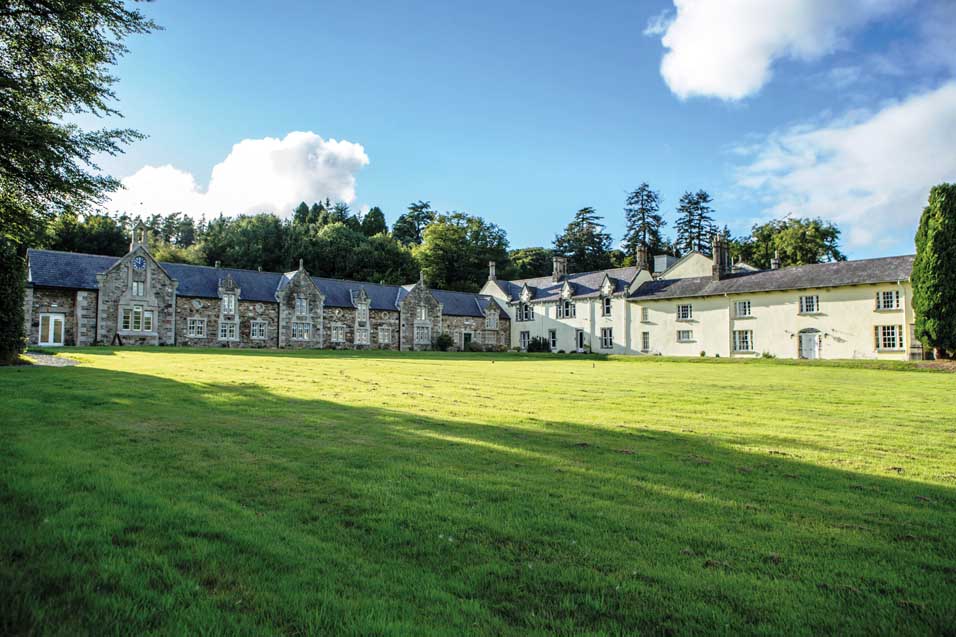Glendalough House
Published in Gems of Architecture, Issue 2 (March/April 2016), Volume 24Annamoe, Co. Wicklow
By Mary Davies
Glendalough House, Co. Wicklow, has been involved with events connected with both sides in the struggle for Irish freedom. The house, originally Drummin, was built by the Hugo family before 1760. In 1798 it belonged to Thomas Hugo, a former high sheriff of Wicklow, a magistrate and firm government supporter. Hugo was notorious for his role in repressing the rebellion in Wicklow, the rebel leader Joseph Holt describing him as ‘a cruel and inhuman tyrant’; locals until recently pointed out ‘Hugo’s hanging tree’ in the demesne. In revenge, the house was burnt by the rebels on 14 June 1798. Government compensation presumably funded the construction of the long, low, two-storeyed replacement house, now the north wing. The dining room has its window-sill at a high level, the popular explanation being that this was so that the Hugos could dine without fear of a rebel’s bullet.
The property was purchased in 1838 by Thomas Johnston Barton, a member of the Bordeaux wine family. In c. 1840 he built a new east-facing front wing in Tudor Revival style at right angles to the older house. This impressive wing has been attributed to the architect Daniel Robertson (d. 1849), who undertook a number of country-house commissions in south-eastern Ireland in the 1830s and ’40s. Robertson also designed the terraces at Powerscourt—the 7th Viscount Powerscourt, writing in his memoirs, painted an enduring picture of the architect, addicted to sherry, often in debt and suffering from gout, being taken around in a wheelbarrow.
The Tudor Revival wing had a symmetrical east front with an overhanging oriel on the left, dormer gables and a battlemented three-sided central bow. The Gothic porte-cochère with finials shown in early twentieth-century photographs was a later addition. Glendalough House, as it was now known, was extended further by a west wing added c. 1880. The additional accommodation was needed when the family was suddenly expanded in size by the addition of five Childers children, double first cousins of the Bartons, when their father died of tuberculosis.
One of these children was Robert Erskine Childers (1870–1922), writer, yachtsman and politician, whose gunrunning on his yacht Asgard has been described as crucial to the Easter Rising; he was elected to the Dáil for Sinn Féin for Kildare–Wicklow in 1921. His cousin Robert Childers Barton (1881–1975), who later inherited the estate, was also a prominent republican after the Easter Rising, elected Sinn Féin MP for West Wicklow in 1918, a signatory of the 1921 treaty, and subsequently minister for agriculture and then for economic affairs.
Glendalough House—‘Glan’ to the family—played a role as background to events in the early twentieth century. As an opponent of the treaty, Erskine Childers was arrested there in 1922 during the Civil War; he was executed on the grounds that his gun (a gift from Michael Collins) was a prohibited weapon and to carry it a capital offence. Robert Barton farmed the estate benevolently during his long life, and before his death in 1975 made it over to Robert Alden (Bobby) Childers, Erskine Childers’s younger son and brother of Erskine Hamilton Childers, president of Ireland. The Tudor Revival east wing was demolished in 1977 and within a decade the house and estate were sold. Glendalough House today consists of the two surviving wings; the old stables are now apartments. The house is a shadow of its former self, but its historical connotations remain.

Glendalough House today. Thomas Hugo’s rebuilt 1800 house (the original was burnt down by rebels in 1798) is to the right. Note the high level of the window-sill of the dining room (second window to the left of the door)—allegedly so that the Hugos could dine without fear of a rebel’s bullet. The former stable block is to the left. (NIAH)
Mary Davies is co-author of Wicklow through the artist’s eye: an exploration of County Wicklow’s historic gardens, c. 1660–c. 1960 (Wordwell, 2014). Series based on the National Inventory of Architectural Heritage’s ‘building of the month’, www.buildingsofireland.ie.
















